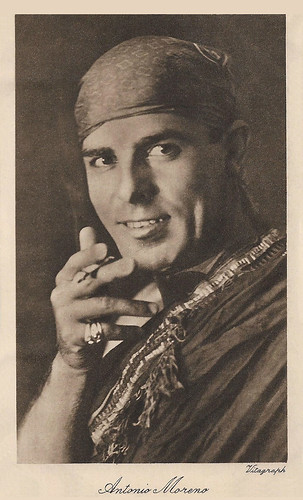
British postcard in the Cinema Chat Series. Photo: Vitagraph.

Romanian postcard. Photo: MGM. Antonio Moreno and Alice Terry in Mare Nostrum (Rex Ingram, 1926).
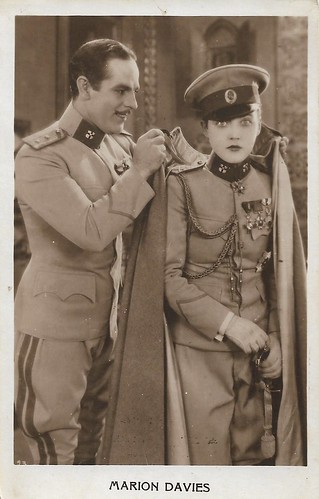
Romanian postcard. Photo: MGM. Marion Davies and Antonio Moreno in Beverly of Graustark (Sidney Franklin, 1926).
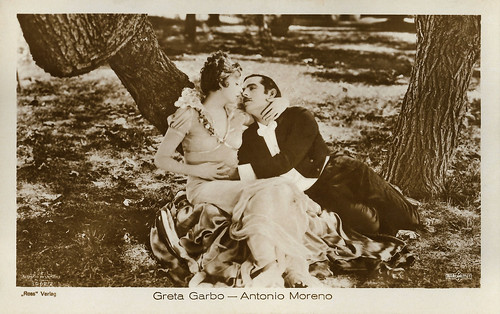
German postcard by Ross Verlag, no. 3062/2, 1928-1929. Photo: Metro-Goldwyn-Mayer / Parufamet. Greta Garbo and Antonio Moreno in The Temptress (Fred Niblo, Mauritz Stiller, 1926).

German postcard by Ross Verlag, no. 4943/1, 1929-1930. Photo: First National Pictures / Defina. Colleen Moore and Antonio Moreno in Synthetic Sin (William A. Seiter, 1929).
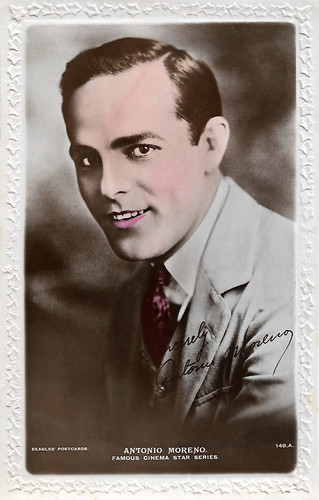
British postcard in the Famous Cinema Stars Series by J. Beagles & Co., London, no. 149. A.
King of the Cliff-hangers
Antonio Moreno was born Antonio Garrido Monteagudo in Madrid, Spain, in 1887. He came to America at the age of fourteen. Although he claimed to have attended Williston Northampton School in Easthampton, Massachusetts, the school's archives have no record of his having done so. His working life began as an employee of the Northhampton Electric Light and Gas Company.
He first acted on stage under the tutelage of Maude Adams whose theatre he had initially visited in order to fix the lighting. From the repertory stage in Massachusetts, he then made his way to Hollywood where he arrived in 1912. Having made his film debut in The Voice of the Millions (Stanner E.V. Taylor, 1912) at Rex-Universal, Moreno then featured as a top draw card for Vitagraph until 1921.
In 1914 Moreno appeared in major films such as Judith of Bethulia (D.W. Griffith, 1914), The Dust of Egypt (George D. Baker, 1915), and John Rance, Gentleman (Van Dyke Brooke, 1914) with Norma Talmadge. Within a short time, he became a star through his appearances opposite Talmadge.
Alongside Ramón Novarro and above all Rudolph Valentino, Moreno rose to become one of the most popular Latin lovers of the silent film era because of his southern good looks. In the process, he acquired a large female fan base. He proudly held the sobriquet "King of the Cliff-hangers" because of his prolific work in serials as co-star to Pearl White.
In the early 1920s, Moreno joined the cinema company Cineplex Entertainment and became one of its highest-paid performers. The pinnacle of his career came a few years later under contract to Famous Players Lasky/Paramount (from 1923 to 1924) and at Metro-Goldwyn-Mayer (in 1926). His film partners included Bebe Daniels in the film version of the Broadway comedy The Exciters (Maurice Campbell, 1923), Pola Negri in The Spanish Dancer (Herbert Brenon, 1923), Greta Garbo in The Temptress (Fred Niblo, Mauritz Stiller, 1926) and Clara Bow in It (Clarence G. Badger, 1927). The comedy It in particular was a huge box office success and featured Moreno as a department store heir who turns the heads of all the shop assistants.
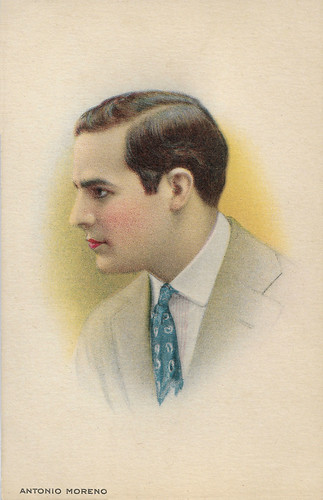
American postcard by Kline Poster Co.

Spanish collectors card by Chocolate Amatller, Series C, Artist no. 4, no. 18. Pola Negri, Antonio Moreno and director Herbert Brenon while shooting the silent film The Spanish Dancer (Herbert Brenon, 1923).
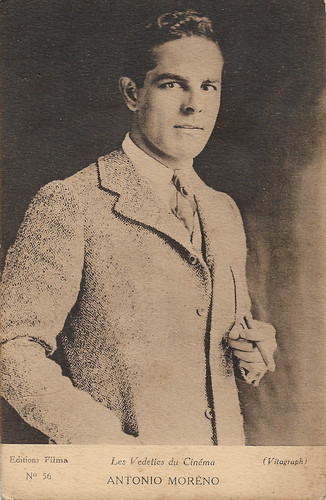
French postcard in the Les Vedettes du Cinéma Series by Ed. Filma, no. 56. Photo: Vitagraph.
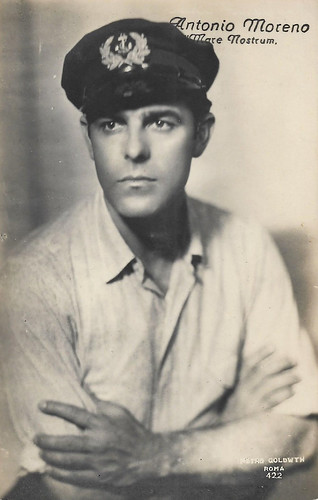
Italian postcard by Ballerini & Fratini, Florence, no. 422. Photo: Metro-Goldwyn, Roma. Antonio Moreno in Mare Nostrum (Rex Ingram, 1926).
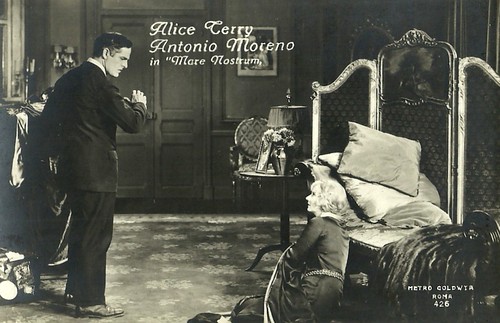
Italian postcard by Ballerini & Fratini, Florence, no. 426. Photo: Metro-Goldwyn, Roma. Antonio Moreno and Alice Terry in Mare Nostrum (Rex Ingram, 1926).

German postcard by Ross Verlag, Berlin, no. 1041/1, 1927-1928. Photo: Phoebus Film.
The cheaply produced horror film became a cult classic
In the 1920s, Antonio Moreno was one of the highest-paid actors in Hollywood. With the advent of sound pictures, his career suffered a sharp decline, in no small measure due to a heavy Spanish accent. He made only a few films in Hollywood during this period and instead worked increasingly in Mexican productions.
During the early 1930s, he also directed several films there, such as the first Mexican sound film Santa (Antonio Moreno, 1932) and the drama Águilas frente al sol/Eagles across the Sun (Antonio Moreno, 1932). Moreno tried to rebuild his Hollywood career as early as the 1930s, including an appearance in the Laurel and Hardy film The Bohemian Girl (James W. Horne, Charley Rogers, 1936) where his character has an affair with Oliver Hardy's wife.
But it wasn't until the mid-1940s that he returned to better roles in American films, including as a character actor in The Captain of Castile (Henry King, 1947) starring Tyrone Power. In 1954, the veteran star took the lead role in the cheaply produced horror film Creature from the Black Lagoon (Jack Arnold, 1954), which became a cult classic over the years.
His last significant appearance was in John Ford's Western epic The Searchers (John Ford, 1956), where he played a Mexican who showed John Wayne and Jeffrey Hunter the way to an Indian chief. Nonetheless, he eventually segued into character parts and remained gainfully employed in the industry until the late 1950s. He was awarded a Star on the Hollywood Walk of Fame at 6651 Hollywood Boulevard in Hollywood, California in 1960.
Moreno was married in 1923 to Daisy Danziger, the daughter of an oil millionaire. Their lavish mansion, called 'Paramour', was one of the largest in Hollywood and the site of many famous parties. Ten years later, Daisy died in 1933 in a tragic car crash near Mulholland Drive. Antonio Moreno passed away in 1967 in Beverly Hills. Following his death from heart failure, he was interred at Forest Lawn Memorial Park in Glendale, California.
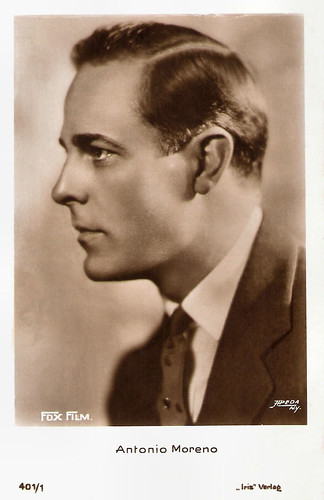
Austrian postcard by Iris Verlag, no. 401/1. Photo: Apeda (Alexander W. Dreyfoos), New York / Fox Film.
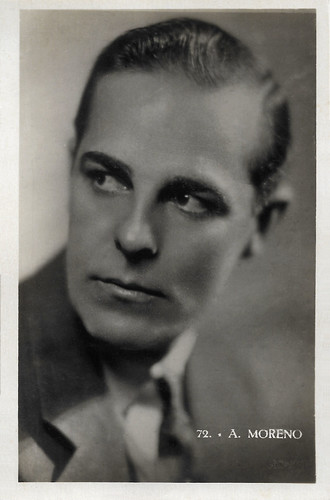
Italian postcard by Foto Ebany (?), no. 72.

Italian postcard by Foto Ebany, sent by mail in 1927. Photo: MGM Antonio Moreno and Alice Terry in Mare Nostrum (Rex Ingram, 1926).
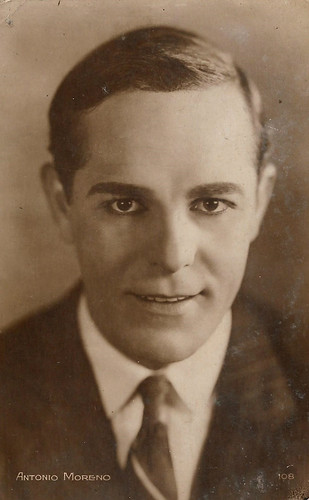
French postcard by Editions Cinémagazine, no. 108.
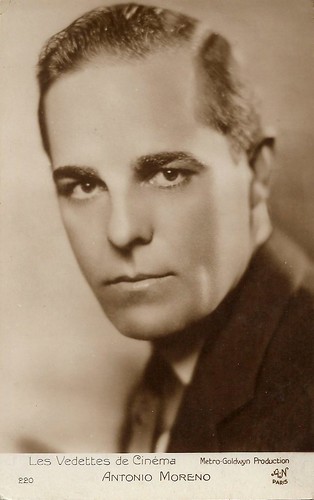
French postcard by A.N., Paris, in the Les vedettes de cinéma series, no. 220. Photo: Metro-Goldwyn.
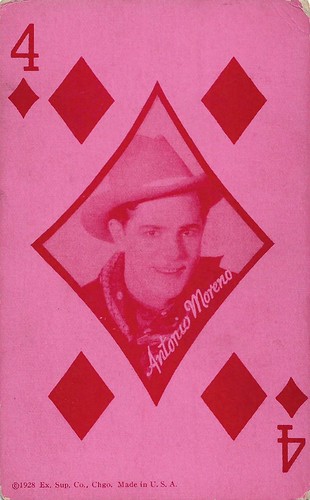
American Arcade postcard by Ex.[Exhibit] Sup[ply]. Co., Chicago, USA, 1928.
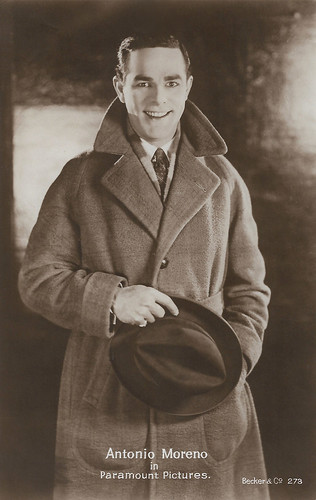
German postcard by Becker & Co., no. 273. Photo: Paramount Pictures.
Sources: I.S. Mowis (IMDb), Wikipedia (German and English) and IMDb.
No comments:
Post a Comment